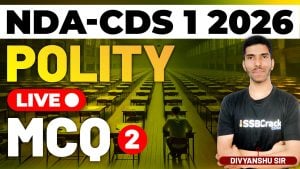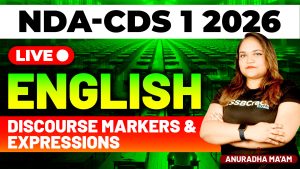Preparing for competitive exams like the National Defence Academy and Naval Academy (NDA-NA) Exam – Paper II (GAT) and the Combined Defence Services (CDS) Exam requires thorough understanding and consistent practice. A recent class focused on the topics Waves and Sound with a dedicated session for practicing multiple-choice questions (MCQs). This practice class was designed to reinforce the conceptual understanding of these topics and provide insights into solving exam-relevant problems efficiently.
Overview of the Class
The session revolved around solving MCQs from previous years, alongside expected and critical questions based on the exam pattern. The aim was not just to solve questions but also to analyze and understand the reasoning behind the answers. Here’s a glimpse of what the class covered:
1. Waves
The questions spanned the foundational aspects of waves, covering topics such as:
- Types of Waves: Mechanical, electromagnetic, and matter waves. Students were tested on their differences and practical examples.
- Wave Motion Characteristics: Concepts like amplitude, wavelength, time period, and frequency were at the core of many MCQs.
- Wave Phenomena: Reflection, refraction, diffraction, interference, and polarization by waves were included, often linked with real-life scenarios like echo formation and light diffraction.
- Electromagnetic Spectrum: Questions on the properties and uses of electromagnetic waves—ranging from radio waves to gamma rays—were common and application-based.
2. Sound
MCQs related to sound tested a wide variety of subtopics:
- Nature of Sound: Its classification as mechanical and longitudinal, and its transmission in different media.
- Audible Range: Questions tested knowledge of infrasound, audible sound, and ultrasound, along with their real-world applications.
- Speed of Sound: Exam-oriented questions explored the factors affecting sound speed, such as temperature, humidity, and medium density.
- Musical Sound Characteristics: Students tackled MCQs differentiating loudness, pitch, intensity, and timbre, with relatable examples like musical instruments and human voices.
- The Human Ear: Anatomy and functioning of the outer, middle, and inner ear were explored, linking the biological aspects of sound perception to physics.
Highlights of the Class
- Conceptual Clarity
Each question was discussed in detail, ensuring that students understood the underlying concepts rather than just memorizing answers. - Exam-Specific Focus
Questions were chosen to align with the exam’s structure and focus, helping students identify the most relevant topics. - Time Management
Students were guided on how to allocate time to each question, with tips for identifying and solving easier ones quickly to leave more time for challenging problems. - Elimination Techniques
Strategies to eliminate incorrect options and narrow down the right answer were shared, particularly useful for solving tricky MCQs.
Strategies for Mastering Waves and Sound
To perform well in the Waves and Sound sections of the NDA-NA and CDS exams, a structured approach is essential. Here are some strategies to help:
1. Strengthen Your Fundamentals
- Build a solid conceptual foundation by reviewing the basics of wave motion, sound characteristics, and related phenomena.
- Use diagrams and real-life examples to visualize and reinforce key concepts.
2. Practice Regularly
- Solve MCQs from previous years to familiarize yourself with the question pattern and difficulty level.
- Attempt practice tests for self-assessment and improvement.
3. Focus on Application-Based Learning
- Many questions in these exams are scenario-based. For instance, you may encounter questions on practical applications of sound waves like sonic booms, ultrasound imaging, or the use of optical fibers for communication.
- Relating theoretical knowledge to real-world situations will enhance your ability to solve such problems.
4. Create Summary Notes
- Prepare concise notes summarizing key points, such as the characteristics of electromagnetic waves or the factors affecting sound speed.
- Include diagrams, flowcharts, or tables to make your notes visually engaging and easy to revise.
5. Develop Analytical Thinking
- Understand the reasoning behind every question, especially the incorrect answers.
- Analyze why certain options are wrong and what makes the correct option valid.
6. Master the Human Ear and Electromagnetic Spectrum
- These are popular areas for questions. Familiarize yourself with the structure of the human ear and the uses of various parts of the electromagnetic spectrum.
- Ensure you know the spectrum in order (radio waves to gamma rays) and their corresponding properties and applications.
7. Leverage Technology
- Use online quizzes, apps, and interactive videos to make your preparation more engaging and efficient.
Conclusion
The recent practice class on Waves and Sound was an excellent opportunity for students to reinforce their understanding of these topics through targeted MCQ solving. With detailed discussions, real-life examples, and effective problem-solving strategies, the session equipped students with the tools needed to tackle this section confidently in the NDA-NA and CDS exams.
By focusing on concepts, practicing diligently, and revising smartly, students can excel in the Waves and Sound sections, setting the stage for overall success. Remember, consistency and clarity are key—let your preparation resonate with precision and determination!



















